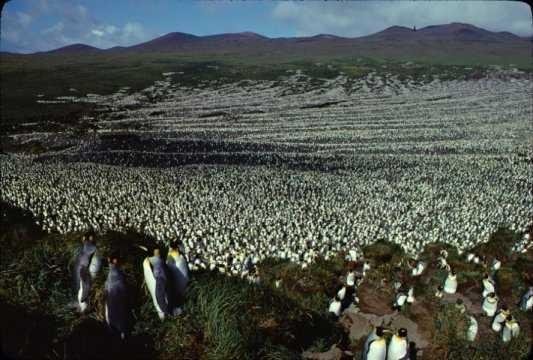Largest king penguin colony has shrunk nearly 90%
The world's biggest colony of king penguins is found in the National Nature Reserve of the French Southern and Antarctic Lands (TAAF). Using high-resolution satellite images, researchers have detected a massive 88 percent reduction in the size of the penguin colony, located on Île aux Cochons, in the Îles Crozet archipelago. The causes of the colony's collapse remain a mystery but may be environmental.

Known since the 1960s, the colony of king penguins (Aptenodytes patagonicus) on Île aux Cochons, in the southern Indian Ocean, had the distinction of being the world's biggest colony of king penguins and second biggest colony of all penguins. However, due to its isolation and inaccessibility, no new estimates of its size were made over the past decades.
The Chizé team used high-resolution satellite images to measure changes in the size of the colony since the island was last visited by a crew of scientists (1982). At the time, the colony included 500,000 breeding pairs and consisted of over two million penguins. To calculate the area occupied by the colony at different times between 1960 and the present, the researchers studied changes in its contours over the years. They found that the colony has shrunk, yielding its territory to encroaching vegetation. Photographs taken from a helicopter during the Antarctic Circumpolar Expedition confirm that the colony's penguin population has plummeted.
Data show that the decline began in the late 1990s, coinciding with a major climatic event in the Southern Ocean related to El Niño. This event temporarily affected the foraging capacities of another colony 100 km from Île aux Cochons, causing it to dwindle. The same process may be responsible for the fate of the Île aux Cochons colony. Its size may also subject it to density-dependent effects. That is, the larger the population, the fiercer the competition between individuals, slowing the growth of all members of the group. The repercussions of lack of food are thus amplified and can trigger an unprecedented rapid and drastic drop in numbers, especially following a climatic event like the one at the end of the 1990s.
Disease is another hypothesis entertained. Avian cholera is currently ravaging populations of seabirds on other islands in the Indian Ocean, like the albatross of Île Amsterdam and the penguins of Marion Island.
Still, none of these possibilities seems to offer a satisfactory explanation for a decline of the magnitude observed on Île aux Cochons. Field studies led by CNRS researchers, with support from the French Polar Institute (IPEV), and in close partnership with TAAF nature reserve staff, should be getting under way shortly to verify initial conclusions drawn from the satellite images.
Source: https://www.sciencedaily.com/releases/2018/07/180730120408.htm